Archaeology and History of Belfast and its Hinterland
It is appropriate that the city of Belfast with its rich archaeological heritage should be chosen to host the European Association of Archaeologists’ annual conference for 2023. People have been living here since Mesolithic times, 9000 years ago at this point where the River Lagan entered the sea and the landscape had an abundance of natural resources. It was also a fording point across the Lagan and by the Medieval period a small settlement had been established, with a castle and church. This settlement grew in size through the seventeenth century but underwent rapid change from the late eighteenth century onwards when it began to emerge as an industrial and manufacturing powerhouse. This period has left us a rich architectural and industrial legacy, the latter perhaps personified best by the Harland and Wolff shipyard and its most famous vessel, RMS Titanic.
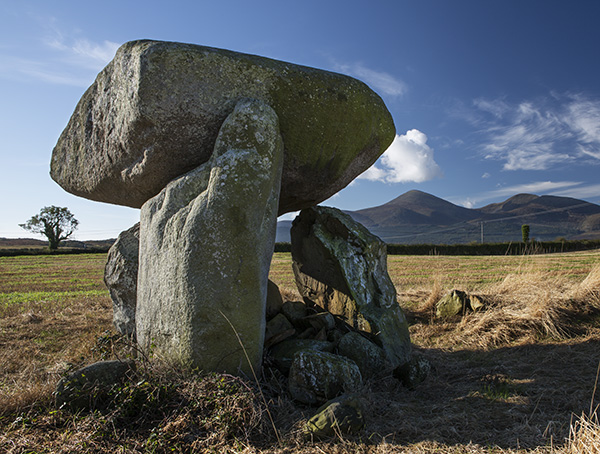
Slidderyford Portal Tomb, Co. Down (Courtesy of Tourism Ireland)
Belfast’s Archaeological Heritage
On the outskirts of the city is a great henge monument, The Giant’s Ring, which dates to the Late Neolithic period and was the focus for a major funerary and ritual prehistoric landscape. The countryside around the city contains archaeological sites such as megalithic tombs and barrows which indicate how this was an important region throughout prehistory and this continued into the Early Medieval period as witnessed by the large number of ringforts (defended farmsteads) that dot the landscape. On Cavehill overlooking the city there is a promontory fort (know locally as McArt’s Fort) that may have been the inauguration site for the kings of the Ulaidh who ruled this area during the first millennium AD. The arrival of the Anglo-Normans in the late twelfth century added new monuments to the landscape, most notably their timber motte and bailey castles, with examples to be found at places such as Belvoir Forest in the suburbs of the city.
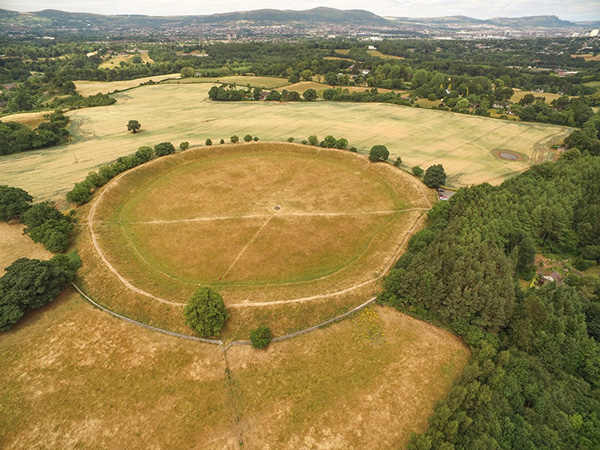
Giant’s Ring, Ballynahatty, Co. Down (Courtesy of David Craig)
The Clandeboye O’Neills were the local Gaelic lords during the Late Medieval period and they had their main castle at Castlereagh, now demolished. The transformations that occurred in Ulster during the early seventeenth century led to the arrival of newcomers from England and Scotland. The town of Belfast came under the control of an Englishman, Sir Arthur Chichester, and experienced a period of development and expansion. Access to Belfast Lough always enabled the town to trade and a timber ship building industry developed; this paved the way for a massive transformation of the town’s fortunes in the nineteenth century when it became an industrial and maritime powerhouse for the British Empire. The new industrial centres required a workforce and Belfast attracted people from the Ulster countryside by their thousands so that by the end of the nineteenth century the population had increased to 350,000.
Archaeology and History of Ireland
The archaeological monuments that exist around Belfast mean that it is ideally suited for the study of all periods of Ireland’s past. The first settlers to our island arrived after the Ice Age around 9000 BC. These hunter-gatherer-fisher folk lived off the natural resources in the Irish landscape. It would seem that new people arrived around 4500 BC and brought agriculture and megalithic tombs with them. These Neolithic settlers also brought new stone technologies and pottery manufacture. The first metallurgists arrived in 2000 BC and during the Bronze Age there was a move towards individual burial in cists and barrows.
The Iron Age commenced in the latter half of the first millennium BC and resulted in the construction of major ceremonial centres such as Navan Fort in modern County Armagh. This is the era of our heroic age exemplified by the stories of Cú Chulainn. It is also the period when we know that Gaelic, a Celtic language, had become the dominant tongue across the island. The Irish Gaels remained outside the Roman Empire but it is evident that cultural and commercial connections existed and the new religion of the Empire, Christianity, had reached our shored during the fifth century AD, exemplified by the arrival of Saint Patrick in AD 432.
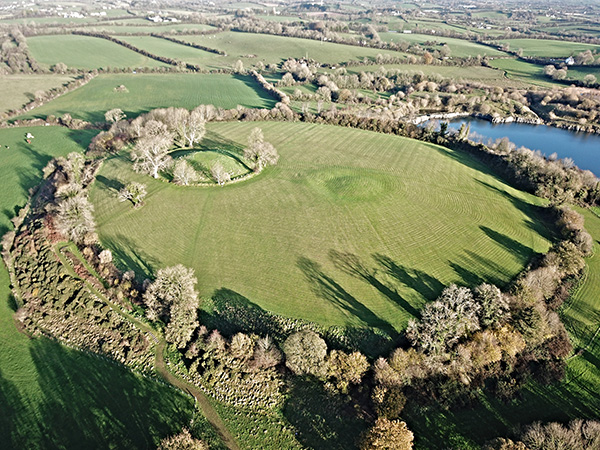
Navan Fort, Co. Armagh (Courtesy of Paddy Gleeson)
During the Early Medieval period power within Ireland rested with a host of small kingdoms, each ruled by their own king. The economic backbone to these kingdoms lay in cattle farming and is expressed today in the form of now abandoned ringforts of which there were once some 30,000. The arrival of the Vikings in the ninth century caused difficulties most notably through their attacks on wealthy monastic communities but by the following century the Vikings had settled and founded new trading centres, such as Dublin, Wexford and Limerick. They had also integrated themselves into Irish life.
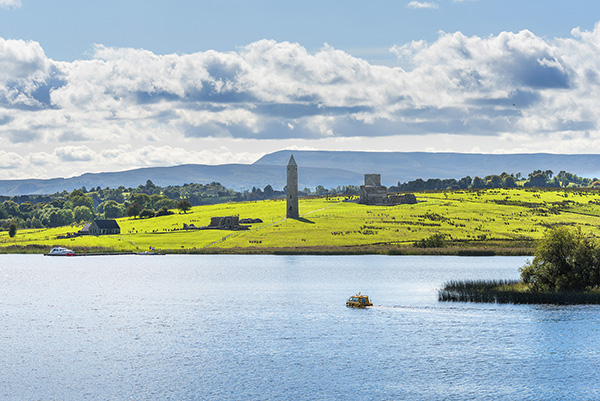
Devenish Island, Co. Fermanagh (Courtesy of Tourism Ireland)
An inter-dynastic conflict between Leinster and Connaught led to the arrival as mercenaries of the first Anglo-Norman adventurers in AD 1169 who proceeded to establish themselves as the rulers of most of the island by AD 1300. After this period, however, there was a regeneration in the fortunes of the Gaels with much of the country coming under their control or resting in the hands of the Anglo-Irish lords, such as Ormond and Kildare. This is the period when Ireland becomes the most castellated part of Europe through the construction of small ‘tower house’ castles.
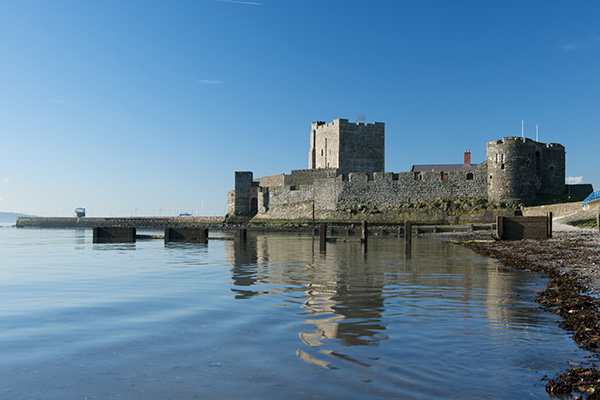
Carrickfergus Castle, Co. Antrim (Courtesy of Tourism Northern Ireland)
The end of the English War of the Roses and the rise to power of the Tudors led to increased interest being given to Ireland by the English Crown and a process of reconquest was played out across the sixteenth century, ending in the Nine Years War (1594-1603) between the Gaelic lordships of Ulster and the Tudor army. The defeat of the Gaelic cause was followed by land confiscations and its redistribution to English and Scottish settlers during the Ulster Plantation.
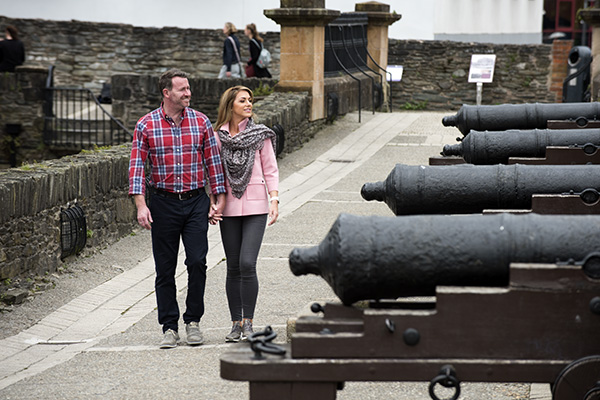
Derry City Walls (Courtesy of Tourism Ireland)
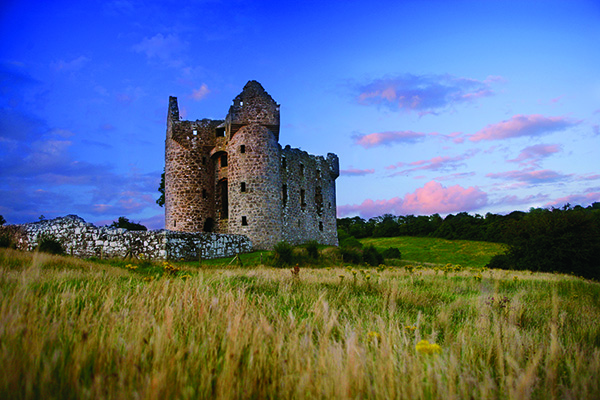
Monea Castle, Co. Fermanagh (Courtesy of Tourism Northern Ireland)
After this time political power increasingly rested in Britain, with formal union completed in 1801 by the establishment of the United Kingdom of Great Britain and Ireland. This relationship was broken in the period 1916 to 1921 when a War of Independence was fought which ended with the partitioning of Ireland into two new jurisdictions. The first of these was the Irish Free State, now the Republic of Ireland, comprising 26 counties, while the second was Northern Ireland, comprising 6 counties and ruled from Belfast.
Political tensions flared in the late 1960s between those who wanted Northern Ireland to join with the 26 counties (Nationalists and Republicans) and those who wanted Northern Ireland to remain within the United Kingdom (Unionists and Loyalists), leading to a 30 year-long conflict and 3,000 deaths. After a long period of negotiation involving local political representatives and members of the UK, Irish and US governments the conflict came to an end in 1998 with the signing of the Good Friday Belfast Agreement, a settlement founded in compromise and one which looked to a peaceful future for all our people together.